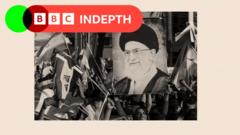The intricate balance of power in the Middle East has been drastically altered following recent military engagements between Iran and the United States. After years of cautious diplomacy and avoiding direct military confrontation, the U.S. has launched significant attacks on key Iranian nuclear facilities, marking a turning point in its relations with Tehran. This high-stakes maneuver comes during a presidential term defined by contradictory approaches to foreign policy and diplomacy.
Iran’s Supreme Leader, Ayatollah Ali Khamenei, who is reportedly in hiding, faces a critical moment that could determine not only his regime’s future but also Iran’s stance within the volatile Middle Eastern political sphere. With the pressure mounting from both domestic and international fronts, Iran is grappling with the weight of its next move—whether to retaliate in a show of strength, which could spiral into broader conflict, or to exercise restraint, preserving its remaining influence.
Analysts indicate that Khamenei is at a crossroads. Sanam Vakil from Chatham House argues that the choices he makes now are pivotal for his legacy. The Iranian regime, already weakened by recent Israeli military action, is wrestling with the need to respond decisively, as failure to act could project a vulnerable image, endangering its domestic stability. The Islamic Revolutionary Guard Corps has threatened retaliation against the U.S., but they, like many, recognize the high stakes involved.
Background tensions simmering for decades have now reached a boiling point, as the U.S. under President Trump, inspired by Israel’s military strategies, seeks to counter perceived threats from Iran. Trump’s insistence on denuclearizing Iran through military action instead of diplomacy echoes previous confrontations, reminiscent of escalated hostilities following the assassination of Qasem Soleimani.
What complicates matters further is the divergence in perspectives; while the U.S. interprets its strikes as a defensive measure, Iran sees them as an act of aggression that jeopardizes its sovereignty and strategic interests. Tehran’s foreign minister has condemned the U.S. for undermining diplomatic efforts, insisting that no negotiations can take place under bombardment.
As discussions for peace fizzle amidst military fire, European leaders are urging for a mediated resolution that emphasizes dialogue over violence. Although concerns regarding a nuclear-armed Iran remain at the forefront, the current trajectory suggests that a path away from armed conflict may be increasingly elusive. Ironically, some experts warn that trampling on Iran's nuclear capabilities could ultimately precipitate the very nuclear threat the U.S. seeks to dismantle.
With the global community watching closely, these developments mark a crucial moment that will undoubtedly mold future relations, security dynamics, and geopolitical stability in the region. Each step taken from here on out carries the weight of potential consequences—both foreseen and unforeseen—for all parties involved.



















